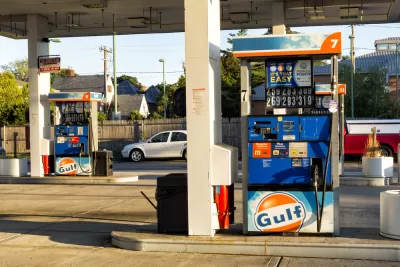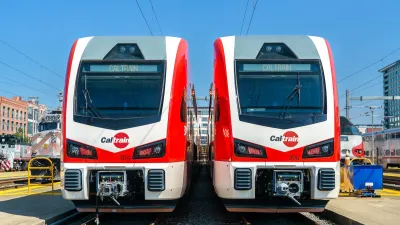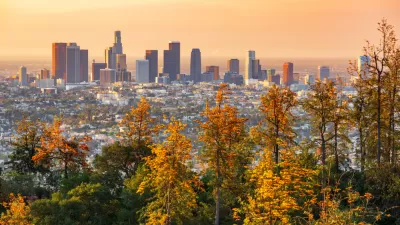The new "50 Steps Toward Carbon-Free Transportation" report examines the gulf between the reality of the U.S. transportation system and the innovations that will be necessary to achieve a carbon-free future.

Tony Dutzik shares new of a new study from the Frontier Group that recommends 50 steps toward carbon-free transportation. The report focuses on the United States, acknowledging that the U.S. transportation system is "Climate Enemy #1."
Dutzik's distillation of the new report includes a lot of quotable facts and illustrative infographics, sure to be of use to those working against the car-centric status quo. For instance, Dutzik includes the following regarding the reality of the U.S. transportation system:
- "Climate change is rarely a factor in transportation decision-making. Only seven states have enforceable, economy-wide limits on carbon pollution, and, as of 2012, the vast majority of states and metropolitan planning organizations did not even consider greenhouse gas emissions in agency planning processes."
- "America spends vastly more on infrastructure for high-carbon modes of travel than low-carbon modes. Between 1956 and 2014, 79 percent of all government capital expenditures on transportation went toward highways, according to Congressional Budget Office data."
- "The federal funding match for new highway projects is generally higher, and the burden of evaluation lower, than major transit capital projects."
Luckily, the report also works from the belief that the United States has the tools to build a carbon-free transportation system, both in policy and in technology. Dutzik lists those tools and explains how each of them can contribute to the cause.
FULL STORY: 50 Steps Toward Carbon-Free Transportation: Rethinking U.S. Transportation Policy to Fight Global Warming

Alabama: Trump Terminates Settlements for Black Communities Harmed By Raw Sewage
Trump deemed the landmark civil rights agreement “illegal DEI and environmental justice policy.”

Planetizen Federal Action Tracker
A weekly monitor of how Trump’s orders and actions are impacting planners and planning in America.

Why Should We Subsidize Public Transportation?
Many public transit agencies face financial stress due to rising costs, declining fare revenue, and declining subsidies. Transit advocates must provide a strong business case for increasing public transit funding.

Phoenix Announces Opening Date for Light Rail Extension
The South Central extension will connect South Phoenix to downtown and other major hubs starting on June 7.

How Housing as a Financial Product Harms Communities
Institutional buyers who treat housing as an investment product become disconnected from the impacts of higher rents, displacement, and housing instability.

Blinded by the Light: When Brighter Headlights Decrease Safety
Bright LED headlights can create glare and reduce visibility for other drivers and pedestrians.
Urban Design for Planners 1: Software Tools
This six-course series explores essential urban design concepts using open source software and equips planners with the tools they need to participate fully in the urban design process.
Planning for Universal Design
Learn the tools for implementing Universal Design in planning regulations.
Caltrans
Smith Gee Studio
Institute for Housing and Urban Development Studies (IHS)
City of Grandview
Harvard GSD Executive Education
Toledo-Lucas County Plan Commissions
Salt Lake City
NYU Wagner Graduate School of Public Service





























